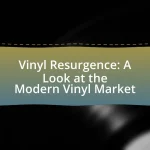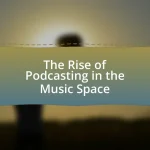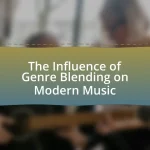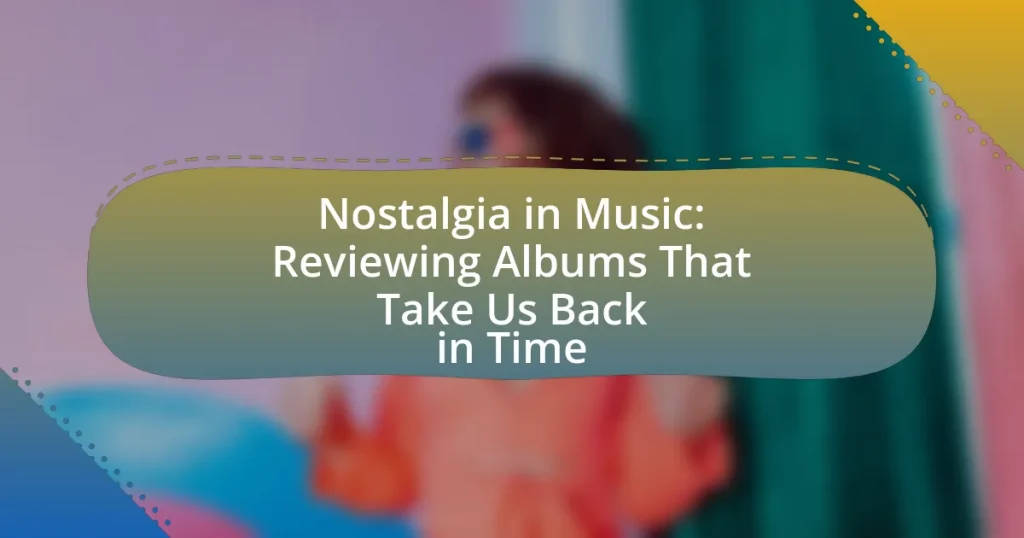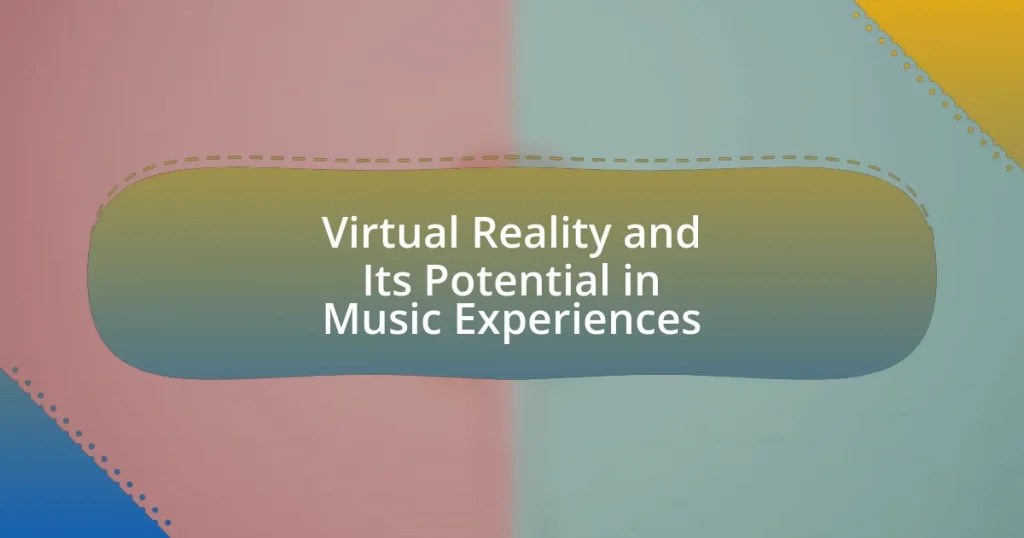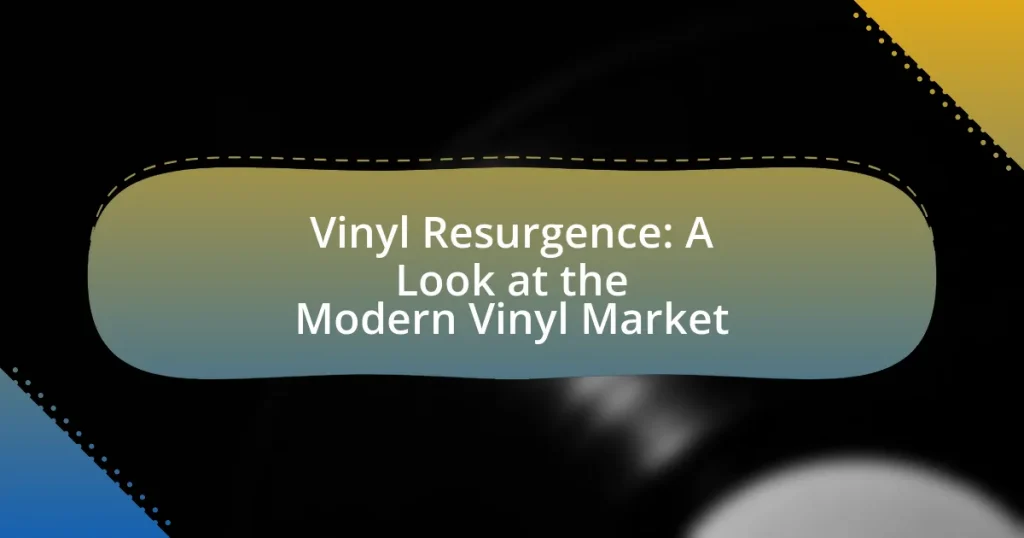Nostalgia in music is the emotional experience of longing for the past, often triggered by specific songs or genres that evoke personal memories. This article explores how nostalgia influences musical preferences, enhances emotional well-being, and shapes memories associated with music. It examines the psychological effects of nostalgia on listeners, the role of cultural and historical contexts, and how artists leverage nostalgic elements in their work. Additionally, the article reviews iconic albums that evoke nostalgia, analyzes the characteristics of nostalgic music across different genres, and provides insights on how listeners can connect with nostalgic albums and create playlists that resonate with their personal histories.
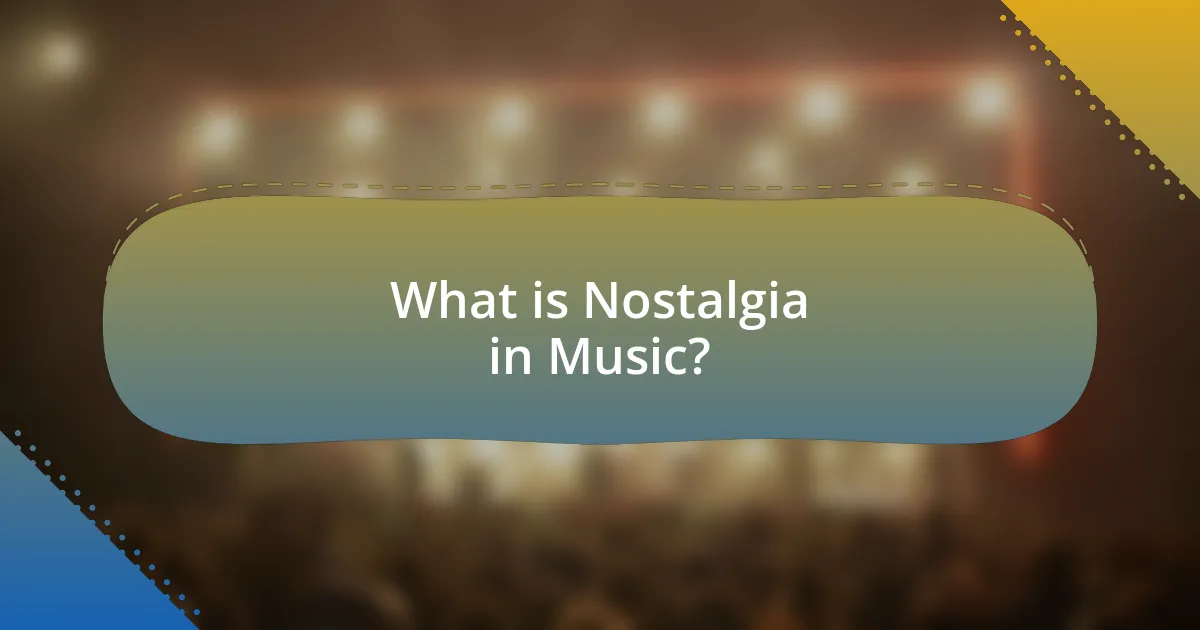
What is Nostalgia in Music?
Nostalgia in music refers to the emotional experience of longing for the past, often evoked by specific songs or genres that remind listeners of earlier times in their lives. This phenomenon is supported by psychological studies indicating that music can trigger vivid memories and emotions associated with personal experiences, enhancing feelings of nostalgia. For instance, research published in the journal “Psychology of Music” demonstrates that familiar melodies can elicit strong emotional responses and memories, reinforcing the connection between music and nostalgia.
How does nostalgia influence our musical preferences?
Nostalgia significantly influences our musical preferences by evoking emotional connections to past experiences and memories associated with specific songs or genres. Research indicates that nostalgic music can trigger positive emotions and enhance mood, leading individuals to favor songs that remind them of significant life events, such as adolescence or early adulthood. A study published in the journal “Psychology of Music” by Janata et al. (2007) found that music from one’s youth is often preferred due to its association with formative experiences, reinforcing the idea that nostalgia shapes our musical tastes by linking them to personal identity and emotional well-being.
What psychological effects does nostalgia have on listeners?
Nostalgia has several psychological effects on listeners, primarily evoking feelings of warmth, happiness, and a sense of belonging. Research indicates that nostalgia can enhance mood and increase feelings of social connectedness, as it often involves recalling positive memories associated with past experiences. A study by Wildschut et al. (2006) published in the Journal of Personality and Social Psychology found that nostalgia can counteract loneliness and foster a sense of continuity in life, providing comfort during times of distress. Additionally, nostalgia can stimulate creativity and inspire individuals by connecting them to their personal history and identity.
How does nostalgia shape our memories associated with music?
Nostalgia significantly shapes our memories associated with music by enhancing emotional connections to specific songs and experiences. Research indicates that music triggers autobiographical memories, often linked to significant life events, which are intensified by nostalgic feelings. For instance, a study published in the journal “Psychology of Music” by Janata et al. (2007) found that familiar songs can evoke vivid memories and emotions, reinforcing the bond between music and personal history. This emotional resonance often leads to a stronger recall of the context in which the music was experienced, making nostalgia a powerful tool in memory formation related to music.
Why do certain albums evoke nostalgia?
Certain albums evoke nostalgia because they are often associated with significant personal memories and emotional experiences. The brain’s limbic system, which processes emotions, links music to memories, making specific songs trigger recollections of past events, relationships, or periods in life. Research indicates that music can activate the same neural pathways as memories, reinforcing the emotional connection. For example, a study published in the journal “Psychology of Music” by authors such as Janata et al. found that familiar songs can elicit vivid autobiographical memories, further supporting the idea that albums serve as auditory time capsules, transporting listeners back to meaningful moments in their lives.
What elements in music contribute to a nostalgic feeling?
Melody, harmony, rhythm, and instrumentation are key elements in music that contribute to a nostalgic feeling. Melodies that evoke memories often utilize familiar scales and motifs, while harmonies can create emotional depth that resonates with past experiences. Rhythmic patterns, especially those reminiscent of specific eras, can trigger recollections of significant moments. Additionally, instrumentation plays a crucial role; certain instruments, like the piano or vintage synthesizers, are associated with particular time periods, enhancing the sense of nostalgia. Research indicates that music activates the brain’s reward system, linking auditory stimuli to emotional memories, thereby reinforcing the nostalgic experience.
How do cultural and historical contexts enhance musical nostalgia?
Cultural and historical contexts enhance musical nostalgia by providing a framework through which listeners can connect emotionally to specific memories and experiences associated with music. For instance, songs from the 1960s often evoke nostalgia for the civil rights movement and counterculture, as they are intertwined with significant social changes. Research indicates that music serves as a powerful trigger for autobiographical memories, with studies showing that individuals often recall personal experiences linked to songs from their formative years, reinforcing the emotional impact of those cultural and historical moments. This connection is further supported by the phenomenon of “cultural memory,” where collective experiences shape the way music is perceived and remembered, making it a vessel for shared nostalgia across generations.
What role does nostalgia play in the music industry?
Nostalgia plays a significant role in the music industry by driving consumer engagement and influencing purchasing decisions. This emotional connection to past experiences often leads to increased sales of music that evokes memories, as evidenced by the resurgence of vinyl records, which saw a 29% increase in sales in 2020, according to the Recording Industry Association of America. Additionally, artists frequently leverage nostalgic elements in their music and marketing strategies, tapping into familiar sounds and themes that resonate with audiences, thereby enhancing their appeal and marketability.
How do artists leverage nostalgia in their work?
Artists leverage nostalgia in their work by incorporating elements from past styles, themes, and cultural references that evoke memories and emotions associated with earlier times. This technique often manifests through the use of vintage sounds, familiar melodies, and lyrical content that resonates with listeners’ personal experiences. For instance, many contemporary musicians sample classic tracks or adopt retro production techniques, which can trigger a sense of familiarity and comfort. Research indicates that nostalgia can enhance emotional responses and increase listener engagement, as evidenced by studies showing that nostalgic music can lead to feelings of happiness and connectedness.
What impact does nostalgia have on album sales and streaming?
Nostalgia significantly boosts album sales and streaming by driving consumer engagement with music that evokes fond memories. Research indicates that nostalgic music can enhance emotional connections, leading to increased purchasing behavior; for instance, a study published in the Journal of Consumer Research found that nostalgia can increase willingness to pay for products, including music albums. Additionally, platforms like Spotify and Apple Music often see spikes in streams for older albums during anniversaries or cultural events, demonstrating that nostalgia not only influences individual purchasing decisions but also shapes broader market trends in music consumption.
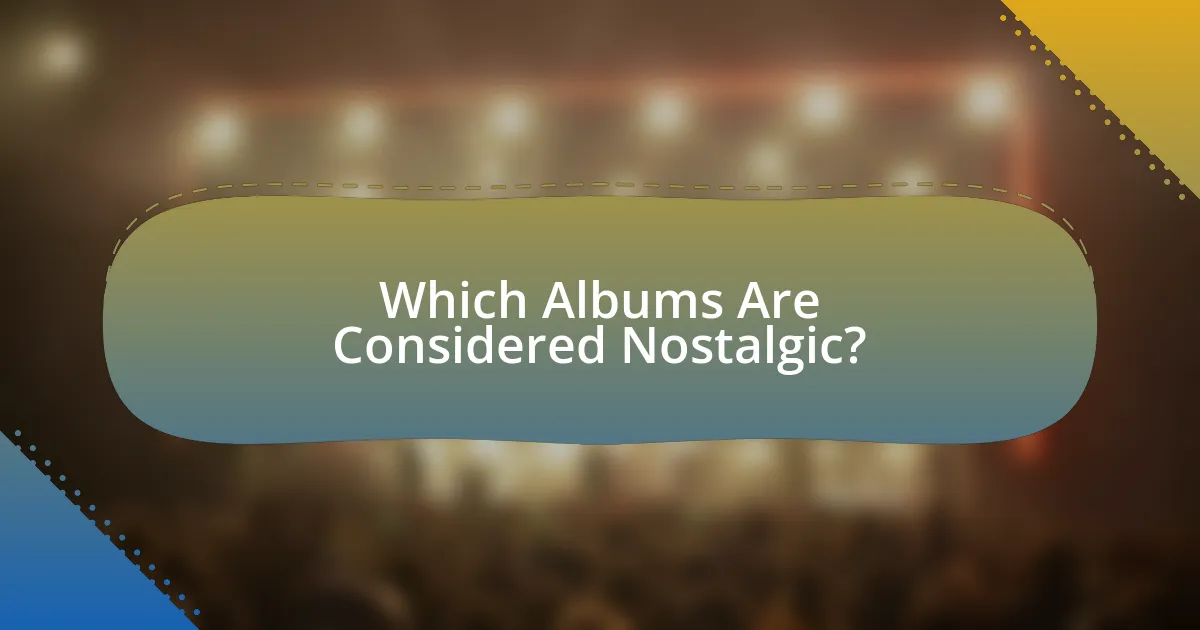
Which Albums Are Considered Nostalgic?
Albums considered nostalgic include “The Beatles’ Sgt. Pepper’s Lonely Hearts Club Band,” “Nirvana’s Nevermind,” and “Fleetwood Mac’s Rumours.” These albums evoke strong feelings of nostalgia due to their significant cultural impact and the era they represent. For instance, “Sgt. Pepper’s” is often associated with the 1960s counterculture, while “Nevermind” marked a pivotal moment in the 1990s grunge movement. “Rumours,” released in 1977, is frequently cited for its timeless themes of love and heartbreak, resonating with listeners across generations. Each of these albums has left a lasting legacy, making them touchstones for personal and collective memories.
What are some iconic albums that evoke nostalgia?
Some iconic albums that evoke nostalgia include “The Beatles’ Sgt. Pepper’s Lonely Hearts Club Band,” “Fleetwood Mac’s Rumours,” and “Nirvana’s Nevermind.” “Sgt. Pepper’s,” released in 1967, is often credited with revolutionizing popular music and is remembered for its innovative production and cultural impact. “Rumours,” released in 1977, captures the emotional turmoil of its creators and remains one of the best-selling albums of all time, resonating with listeners for its relatable themes. “Nevermind,” released in 1991, marked a significant shift in music with its raw sound and is frequently associated with the grunge movement, evoking memories of the early ’90s. Each of these albums has left a lasting legacy, making them touchstones for nostalgia in music.
How do these albums reflect the era they represent?
These albums reflect the era they represent by encapsulating the cultural, social, and musical trends of their time. For instance, the use of specific instrumentation, lyrical themes, and production techniques in these albums mirrors the prevailing attitudes and experiences of the period. Albums from the 1960s often feature political and social commentary, reflecting the civil rights movement and counterculture, while 1980s albums may showcase the rise of technology and consumerism through synthesizers and pop aesthetics. The historical context, such as the Vietnam War’s influence on music in the 1970s or the economic shifts of the 1980s, further validates how these albums serve as a sonic representation of their respective eras.
What themes are commonly found in nostalgic albums?
Common themes found in nostalgic albums include reminiscence, longing for the past, and personal memories. These albums often evoke feelings of nostalgia by referencing specific cultural moments, childhood experiences, or significant life events. For instance, artists may incorporate sounds, lyrics, or production styles reminiscent of earlier musical eras, such as the 1980s synth-pop or 1990s grunge, to create a sense of familiarity and emotional connection. This approach is supported by studies indicating that nostalgia can enhance emotional well-being and foster social connections, as seen in research published in the journal “Emotion” by Wildschut et al. (2006), which highlights how nostalgic music can trigger memories and feelings associated with past experiences.
How do different genres approach nostalgia in music?
Different genres approach nostalgia in music through distinct thematic elements and stylistic choices. For instance, rock music often evokes nostalgia by referencing past cultural movements and utilizing classic instrumentation, as seen in the resurgence of 70s and 80s rock sounds in contemporary bands. In contrast, hip-hop frequently incorporates samples from older tracks, creating a direct link to past eras and celebrating their influence, exemplified by artists like J. Cole and Kendrick Lamar who reference earlier hip-hop legends. Meanwhile, country music often tells stories that reflect on personal memories and simpler times, as demonstrated by artists like Kacey Musgraves, who blend traditional sounds with modern narratives. Each genre utilizes its unique characteristics to evoke feelings of nostalgia, whether through lyrical content, instrumentation, or sampling techniques.
What are the characteristics of nostalgic elements in pop music?
Nostalgic elements in pop music are characterized by the use of retro sounds, familiar melodies, and lyrical themes that evoke memories of the past. These elements often include the incorporation of vintage instrumentation, such as synthesizers or drum machines reminiscent of earlier decades, which create a sonic landscape that feels familiar to listeners. Additionally, pop songs may feature lyrical references to cultural icons, events, or experiences from previous eras, further enhancing the sense of nostalgia. For example, artists like Dua Lipa in her album “Future Nostalgia” utilize disco influences and 80s pop aesthetics to connect with listeners’ memories, demonstrating how nostalgia can be effectively woven into contemporary music.
How does nostalgia manifest in rock versus hip-hop albums?
Nostalgia in rock albums often manifests through themes of personal memories, cultural references, and a longing for past eras, while hip-hop albums typically express nostalgia through storytelling, sampling older tracks, and reflecting on historical social issues. Rock artists frequently evoke nostalgia by referencing specific events or emotions tied to their youth, as seen in albums like Bruce Springsteen’s “Born to Run,” which captures the essence of American youth in the 1970s. In contrast, hip-hop artists like J. Cole in “2014 Forest Hills Drive” utilize storytelling to reminisce about their upbringing and the struggles faced, often incorporating samples from classic tracks to connect past and present. This difference highlights how rock leans towards personal and cultural nostalgia, while hip-hop emphasizes narrative and social context.

How Can We Analyze Nostalgic Albums?
To analyze nostalgic albums, one should examine the emotional connections they evoke, the historical context of their release, and the musical elements that contribute to their nostalgic appeal. Emotional connections can be assessed through listener testimonials and cultural impact, as albums often resonate with specific life experiences or collective memories. Historical context involves understanding the era in which the album was released, including social, political, and technological influences that shaped its sound and reception. Musical elements such as instrumentation, lyrical themes, and production techniques can be analyzed to identify characteristics that trigger nostalgia, as studies show that familiar melodies and lyrics can elicit strong emotional responses. For instance, a study published in the journal “Psychology of Music” found that music from one’s youth is often associated with significant life events, reinforcing the nostalgic experience.
What criteria should we use to evaluate nostalgic albums?
To evaluate nostalgic albums, one should consider emotional resonance, historical context, musical composition, and cultural impact. Emotional resonance refers to how well the album evokes personal memories and feelings associated with a specific time period. Historical context involves understanding the era in which the album was released, including social and political influences that shaped its creation. Musical composition examines the quality of songwriting, instrumentation, and production techniques that contribute to the album’s overall sound. Cultural impact assesses how the album influenced or reflected societal trends, movements, or changes in music genres. These criteria collectively provide a comprehensive framework for evaluating the significance and effectiveness of nostalgic albums.
How do lyrical content and instrumentation contribute to nostalgia?
Lyrical content and instrumentation significantly contribute to nostalgia by evoking memories and emotions associated with past experiences. Lyrics that reference specific events, places, or cultural touchstones can trigger personal recollections, as they often resonate with listeners’ own histories. For instance, songs that mention childhood activities or significant life moments create a direct connection to the listener’s past, enhancing the nostalgic experience.
Instrumentation also plays a crucial role; certain musical styles, sounds, or production techniques can evoke specific eras or feelings. For example, the use of vintage instruments or production methods reminiscent of a particular decade can transport listeners back to that time, reinforcing the emotional impact of the lyrics. Research indicates that music can activate brain regions associated with memory recall, further solidifying the connection between musical elements and nostalgic feelings. Thus, both lyrical content and instrumentation work together to create a powerful sense of nostalgia in music.
What role does production quality play in the nostalgic experience?
Production quality significantly enhances the nostalgic experience by evoking specific auditory memories associated with past music. High production quality can recreate the soundscapes of earlier eras, allowing listeners to connect emotionally with their memories. For instance, the use of analog recording techniques in modern music can mimic the warmth and texture of recordings from the 1970s, triggering nostalgia for listeners who grew up during that time. Studies show that familiar sounds and production styles can activate the brain’s reward system, reinforcing positive emotional responses linked to past experiences. Thus, production quality serves as a crucial element in shaping and intensifying the nostalgic experience in music.
How can listeners connect with nostalgic albums on a deeper level?
Listeners can connect with nostalgic albums on a deeper level by engaging with the personal memories and emotions associated with the music. This connection is often facilitated by the familiarity of melodies, lyrics, and production styles that evoke specific time periods or experiences in a listener’s life. Research indicates that music can trigger autobiographical memories, enhancing emotional responses; for instance, a study published in the journal “Psychology of Music” found that songs from one’s youth can elicit vivid recollections and feelings of nostalgia, reinforcing the bond between the listener and the album. By actively reflecting on these memories while listening, individuals can deepen their emotional engagement and appreciation for the music.
What personal experiences enhance the nostalgic listening experience?
Personal experiences that enhance the nostalgic listening experience include significant life events, relationships, and cultural moments associated with specific songs or albums. For instance, a song played during a memorable summer vacation can evoke vivid memories of that time, creating a strong emotional connection. Research indicates that music can trigger autobiographical memories, as demonstrated in a study by Janata et al. (2007), which found that familiar songs activate brain regions linked to memory retrieval. This connection between music and personal history reinforces the nostalgic experience, making it more profound and emotionally resonant.
How can we create playlists that evoke nostalgia?
To create playlists that evoke nostalgia, select songs that were popular during significant periods of your life, such as childhood or adolescence. Research indicates that music from these formative years can trigger emotional memories, as demonstrated by a study published in the journal “Psychology of Music,” which found that familiar songs can elicit vivid recollections and feelings associated with past experiences. Additionally, incorporating tracks that feature specific cultural references or events from those times can enhance the nostalgic effect, as they resonate with shared memories and collective experiences.
What are some tips for exploring nostalgic music effectively?
To explore nostalgic music effectively, start by identifying genres or artists that were significant during your formative years. This approach allows for a personal connection to the music, enhancing the nostalgic experience. Utilize streaming platforms that offer curated playlists based on specific decades or themes, as these can guide you to discover tracks that evoke memories. Engaging with music forums or social media groups dedicated to nostalgic music can provide recommendations and insights from others who share similar experiences. Research shows that listening to music from one’s past can trigger emotional responses and memories, reinforcing the effectiveness of this exploration method.

